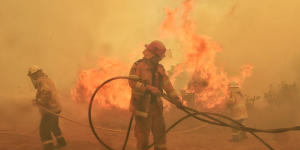In Australia,there are more than 370,000 full-time and volunteer emergency workers,including police,fire and rescue,and ambulance personnel,as well as volunteers from organisations such as the State Emergency Services (SES),Coast Guard,Marine Rescue,Rural Fire Service,and lifesavers.
It is no surprise these capable and calm people,who respond to unimaginably traumatic events,are viewed as one of the most valued and trusted occupational groups.
There is an enormous psychological toll when,as former volunteer firefighter Elisabeth Goh says in,“Everybody’s worst day is your every day.”

Firefighters battling the Black Summer bushfires in 2019.Nick Moir
That toll can be seen in the disproportionately high rates of post-traumatic stress disorder (PTSD) experienced by emergency workers compared to other professions. The current estimate is it will affect one in 10 personnel.
The Black Dog Institute and the University of NSW have launched updated guidelines for the treatment of PTSD in emergency workers in recognition of the large numbers reporting ongoing psychological consequences of exposure to trauma.
The term “post-traumatic stress disorder” came into use in the 1970s in relation to Vietnam War veterans,but the condition has long been recognised where people exposed to death,assault or injury experience psychological consequences.
It can result from a single significant event or,as in the case of emergency workers,from sustained and repeated exposure to the type of trauma that is part of their normal work.
They may witness scenes where people have been badly hurt or lost their lives,be directly threatened or required to make life-or-death decisions in volatile conditions to maintain community safety.
The pressure of this can manifest in flashbacks and nightmares,avoidance of the reminders of the trauma,memory loss,irritability and sleeping and concentration difficulties.
Professor Sam Harvey,executive director and chief scientist of the Black Dog Institute and the lead co-author of the guidelines,said it was the influx of workers after the Black Summer fires that led to the update.
This means Australia now leads the world in addressing the unique challenges of emergency service workers.
As noted in the Expert Guidelines document,the existing Australian guidelines were limited and did not adequately address the specificity and extremity of the emergency worker experience.
Treatment plans also were predicated on the idea that the sufferer could be removed from the situation,which has acted as a trigger,which is not the case in this type of work-related trauma.
The valuable work by Black Dog and UNSW has not only provided a framework for mental health practitioners treating emergency workers but has also identified ways to better insulate emergency workers from PTSD with strategies such as resilience training and wellbeing checks.
Elisabeth Goh is one of the emergency workers who was impacted by the toll of the Black Summer fires. She told our reporter of the feelings of helplessness,guilt and shame she felt from not being able to save a home or a life.
She suffered from sleeplessness,a lack of concentration and problems with her close relationships. However,it took her some time to connect her anxiety and insomnia to PTSD and start seeing an emergency services specialist.
Thanks to the new Expert Guidelines,emergency service workers such as Goh will now receive the gold standard in support.
It has been well-documented that climate change means we should expect an increase in the cadence and severity of extreme weather events. We owe it to people like Goh to ensure they are supported in their valuable work.